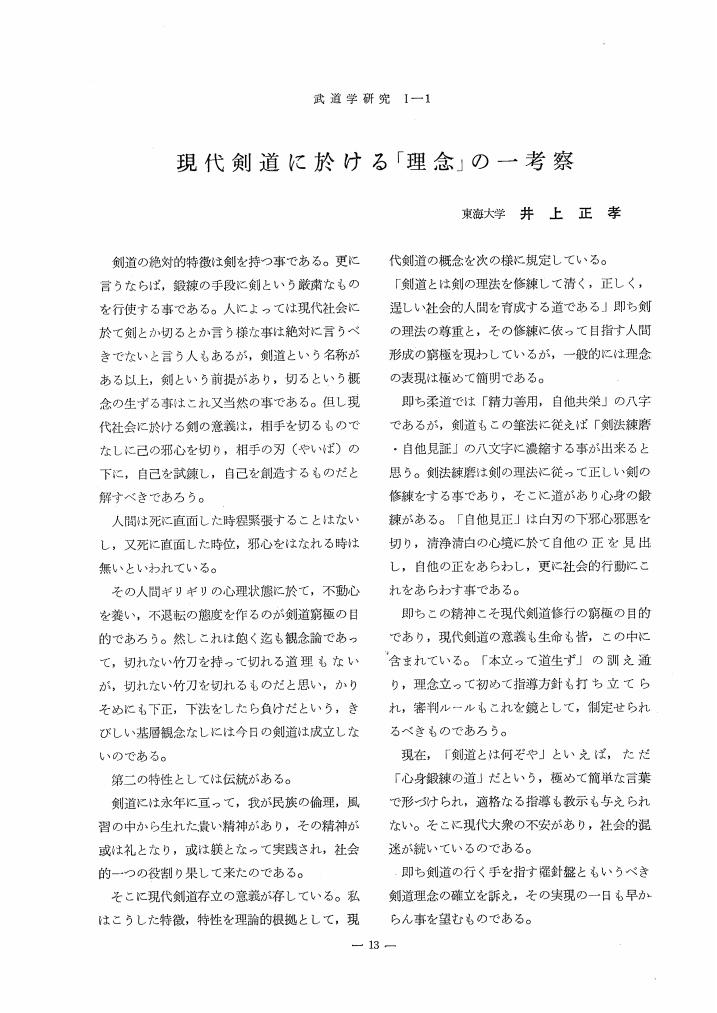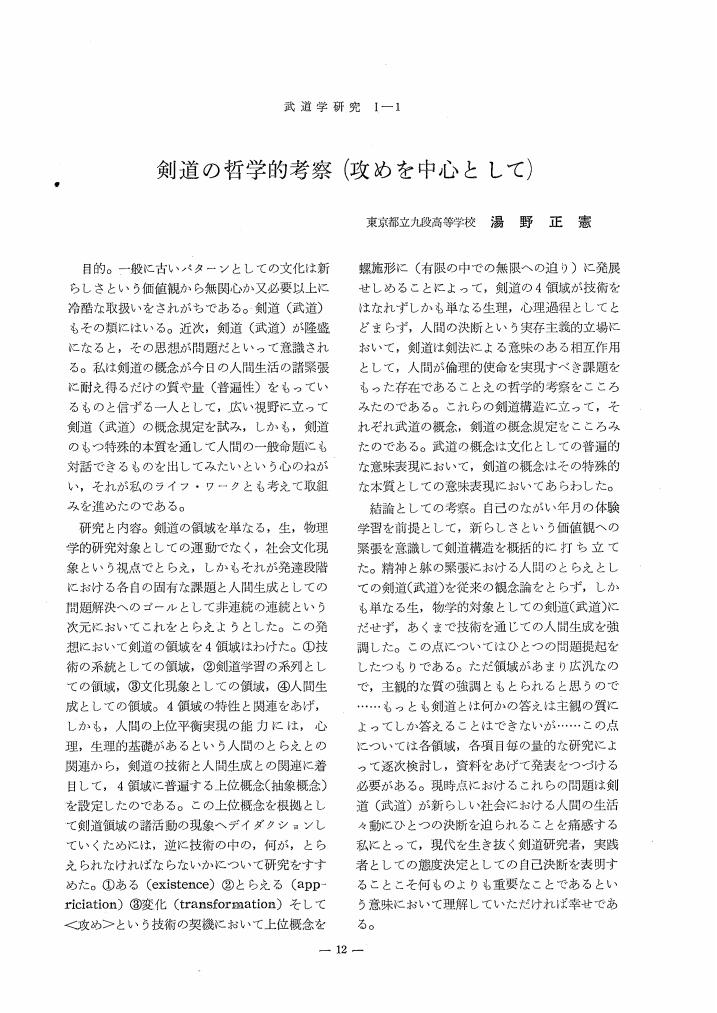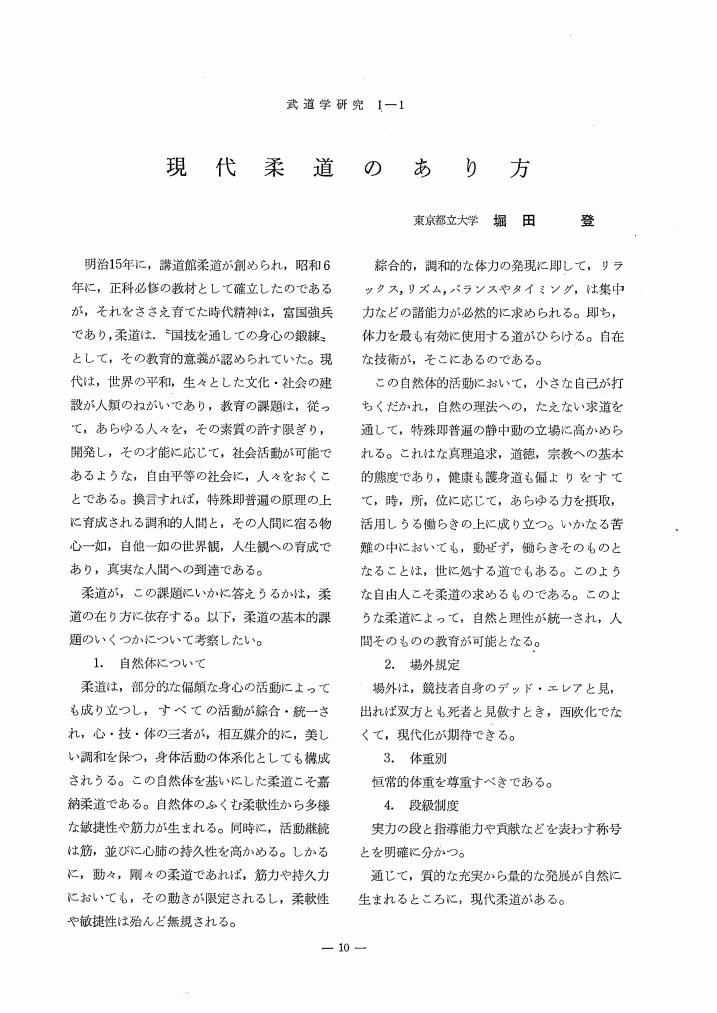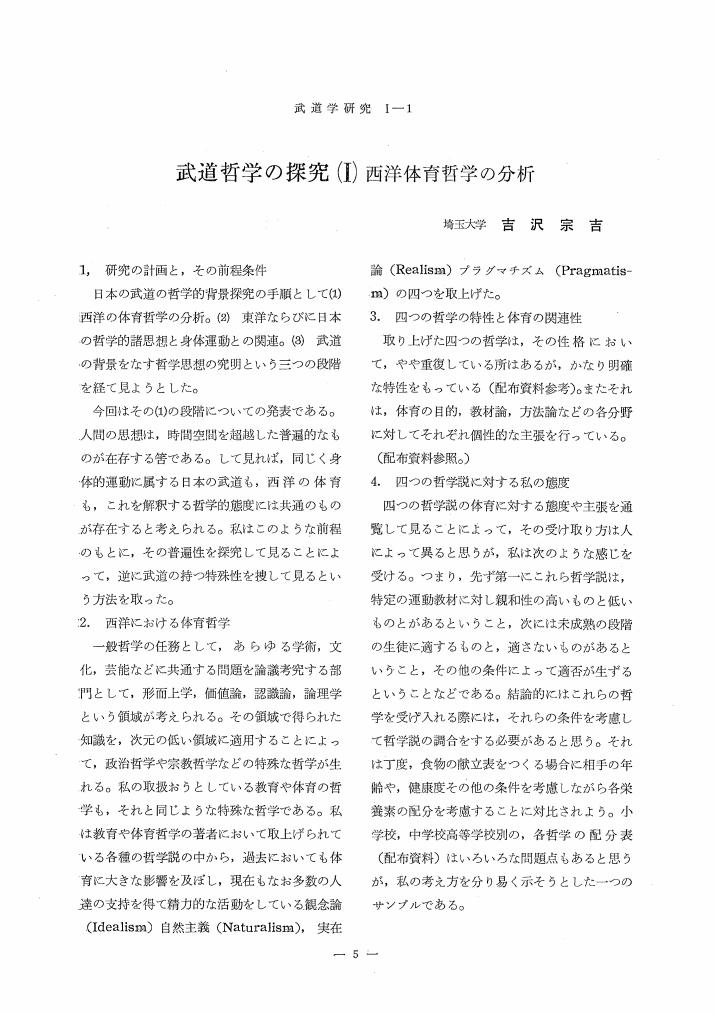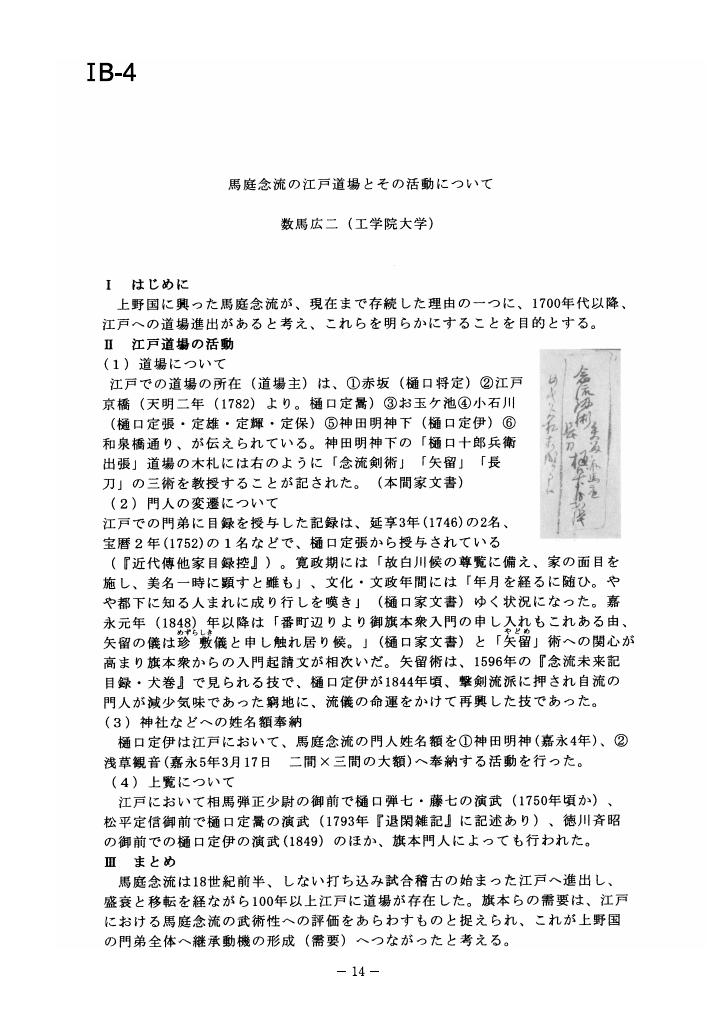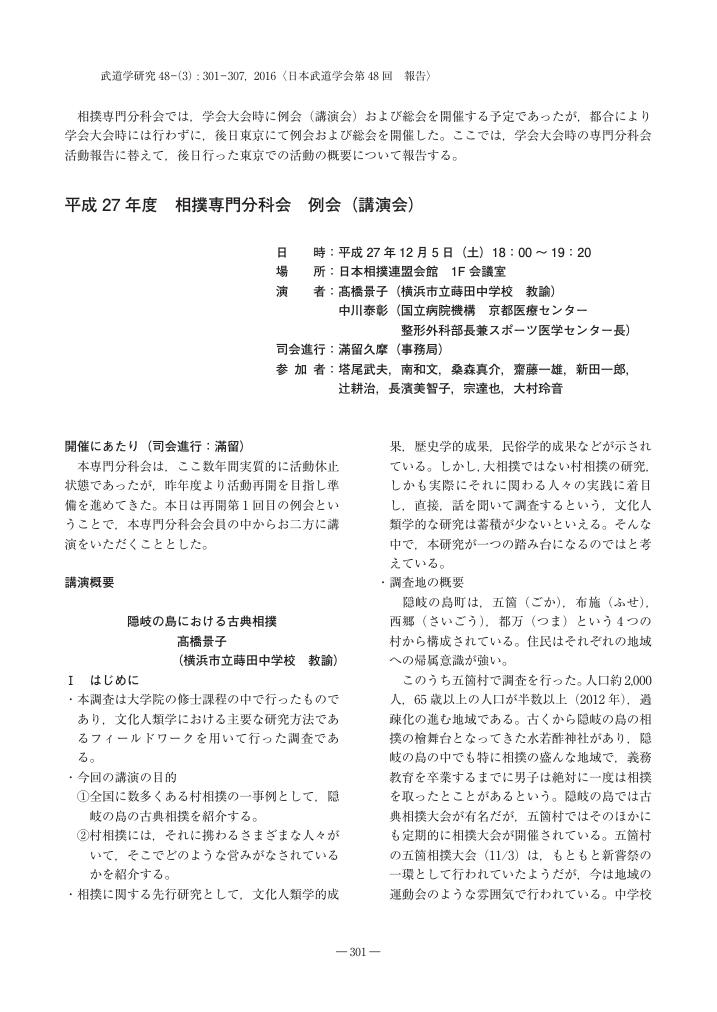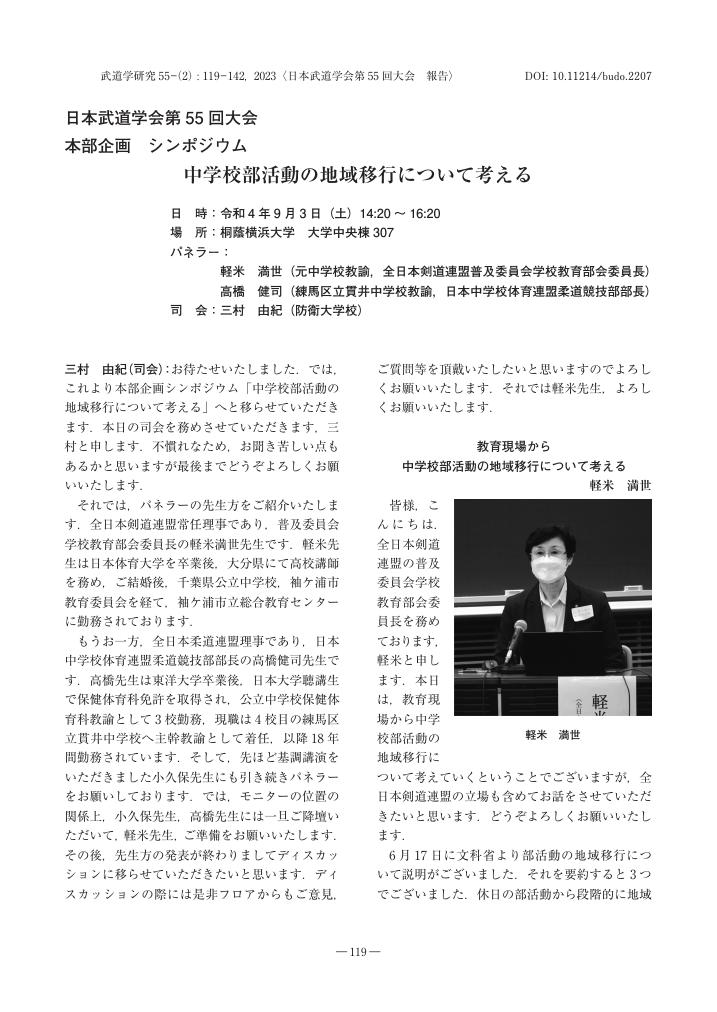1 0 0 0 OA 剣道の試合に関する研究(その2) ―決め技の分類と決め技発生に要した時間について―
- 著者
- 岩下 巳伸
- 出版者
- 日本武道学会
- 雑誌
- 武道学研究 (ISSN:02879700)
- 巻号頁・発行日
- vol.1, no.1, pp.17, 1968-12-25 (Released:2012-11-27)
1 0 0 0 OA 現代剣道に於ける「理念」の一考察
- 著者
- 井上 正孝
- 出版者
- 日本武道学会
- 雑誌
- 武道学研究 (ISSN:02879700)
- 巻号頁・発行日
- vol.1, no.1, pp.13, 1968-12-25 (Released:2012-11-27)
1 0 0 0 OA 剣道の哲学的考察(攻めを中心として)
- 著者
- 湯野 正憲
- 出版者
- 日本武道学会
- 雑誌
- 武道学研究 (ISSN:02879700)
- 巻号頁・発行日
- vol.1, no.1, pp.12, 1968-12-25 (Released:2012-11-27)
1 0 0 0 OA 柔道の目付について
- 著者
- 松本 芳三
- 出版者
- 日本武道学会
- 雑誌
- 武道学研究 (ISSN:02879700)
- 巻号頁・発行日
- vol.1, no.1, pp.11, 1968-12-25 (Released:2012-11-27)
1 0 0 0 OA 現代柔道のあり方
- 著者
- 堀田 登
- 出版者
- 日本武道学会
- 雑誌
- 武道学研究 (ISSN:02879700)
- 巻号頁・発行日
- vol.1, no.1, pp.10, 1968-12-25 (Released:2012-11-27)
1 0 0 0 OA 柔道史上に於ける疑問点についての解明
- 著者
- 佐藤 忠吾
- 出版者
- 日本武道学会
- 雑誌
- 武道学研究 (ISSN:02879700)
- 巻号頁・発行日
- vol.1, no.1, pp.9, 1968-12-25 (Released:2012-11-27)
1 0 0 0 OA 武道の現代化への一考察
- 著者
- 阿部 忍
- 出版者
- 日本武道学会
- 雑誌
- 武道学研究 (ISSN:02879700)
- 巻号頁・発行日
- vol.1, no.1, pp.8, 1968-12-25 (Released:2012-11-27)
1 0 0 0 OA 安全教育としての武道教育
- 著者
- 富木 謙治
- 出版者
- 日本武道学会
- 雑誌
- 武道学研究 (ISSN:02879700)
- 巻号頁・発行日
- vol.1, no.1, pp.7, 1968-12-25 (Released:2012-11-27)
1 0 0 0 OA 武道哲学の探究(I)西洋体育哲学の分析
- 著者
- 吉沢 宗吉
- 出版者
- 日本武道学会
- 雑誌
- 武道学研究 (ISSN:02879700)
- 巻号頁・発行日
- vol.1, no.1, pp.5, 1968-12-25 (Released:2012-11-27)
1 0 0 0 OA 武道の概念(概念規定に関する試論)
- 著者
- 佐藤 和兄
- 出版者
- 日本武道学会
- 雑誌
- 武道学研究 (ISSN:02879700)
- 巻号頁・発行日
- vol.1, no.1, pp.4, 1968-12-25 (Released:2012-11-27)
1 0 0 0 OA 武道の文化性 ―薩摩藩における武道教育―
- 著者
- 村山 輝志
- 出版者
- 日本武道学会
- 雑誌
- 武道学研究 (ISSN:02879700)
- 巻号頁・発行日
- vol.19, no.1, pp.17-25, 1986-07-31 (Released:2012-11-27)
- 参考文献数
- 44
- 被引用文献数
- 2
There have been many discussions about whether Budo is considered to be a sport or not. Ancient Budo was a part of traditional Japanese culture, but it has developed into a competitive sport. Budo has made contributions to many aspects of our society: for example, to the arts, to the education, and so on.The Satsuma feudal clan's emphasis on education promoted it to build the first Budo gymnasium, including the Inuomono stadium and the Zoshi gym, despite of the clan's great debt.The courses of the sword was most emphasized; horseriding and archery were taught every day and the handle of a long sword and a spear were done every other day.The Satsuma teachers of Budo were the first persons who with feudal masters went to Edo to study Budo. Other feudal clans came to Satsuma to teach errantry of knights.The Budo school had its foundations before the modern times and since then, it has spread throughout Japan.
- 著者
- 上野 孫吉
- 出版者
- 日本武道学会
- 雑誌
- 武道学研究 (ISSN:02879700)
- 巻号頁・発行日
- vol.12, no.1, pp.15-17, 1980-01-30 (Released:2012-11-27)
- 参考文献数
- 33
1 0 0 0 OA 馬庭念流の江戸道場とその活動について
- 著者
- 数馬 広二
- 出版者
- 日本武道学会
- 雑誌
- 武道学研究 (ISSN:02879700)
- 巻号頁・発行日
- vol.44, no.Supplement, pp.S_14, 2011 (Released:2012-08-31)
1 0 0 0 OA 平成27年度 相撲専門分科会 例会(講演会)
1 0 0 0 OA 中学校部活動の地域移行について考える
1 0 0 0 OA 武道・スポーツの基礎となる棒の力学:特に慣性力の重要性
- 著者
- 坂井 伸之 牧 琢弥 竹田 隆一
- 出版者
- 日本武道学会
- 雑誌
- 武道学研究 (ISSN:02879700)
- 巻号頁・発行日
- vol.49, no.1, pp.15-27, 2016-08-18 (Released:2018-03-12)
- 参考文献数
- 5
- 被引用文献数
- 1
In budo and sports, most coaching words are abstract and intuitive, and their true meanings and scientific foundations are ambiguous. To understand complex movements scientifically, it is important to reduce them into simple models and to analyze them on the basis of mechanical laws. In this paper, as the first step in the theoretical study of movements, we consider the mechanics of bar models, which are applicable to various movements in budo and sports. In particular, we focus on the effects of inertial force on human movements, which have so far been overlooked. We also discuss the restorative force of muscles and gravity, which act in cooperation with inertial force. As a result, we found the mechanisms of some typical movements. For example, we interpret “kinetic link” as the combination of inertial force acting on a rigid body and restoring the force of muscles, and clarify the scientific meaning of “weight shift” in terms of the equivalence of gravity and inertial force.
1 0 0 0 OA 大学男女剣道選手の骨密度特性
- 著者
- 山神 眞一 石川 雄一 境 英俊 藤原 章司 阿部 純也 宮本 賢作 長野 智香
- 出版者
- 日本武道学会
- 雑誌
- 武道学研究 (ISSN:02879700)
- 巻号頁・発行日
- vol.37, no.3, pp.13-23, 2005-03-31 (Released:2012-11-27)
- 参考文献数
- 30
A study was conducted to investigate the influence of kendo exercise on the bone mineral density in male and female university kendo athletes. The subjects were 45 male university kendo athletes and 23 female university kendo athletes. They had an average kendo experience of 13.2 years and 10.0 years. Measurements were performed using an AOS100 (ALOKA Corp.). We measured the speed of sound (SOS), transmission index (TI), and osteo sonoassessment index (OSI). The mean values of SOS, TI, and OSI in male and female university kendo athletes were higher than in the same aged control group and the peak bone mass aged control group.The values of the left heel were significantly higher than that of the right heel in bone mineral density. Body weight was significantly related to bone mineral density in male and female university kendo athletes. These results suggest that regular kendo exercise during youth is effective for the increase in bone mineral density.
1 0 0 0 武道学研究 = Research journal of Budo
- 著者
- 日本武道学会 = Japanese Academy of Budo
- 出版者
- 日本武道学会
- 巻号頁・発行日
- 1968
1 0 0 0 OA 武芸伝書にみられる事理について(その2)
- 著者
- 湯浅 晃
- 出版者
- 日本武道学会
- 雑誌
- 武道学研究 (ISSN:02879700)
- 巻号頁・発行日
- vol.18, no.2, pp.53-54, 1985-11-30 (Released:2012-11-27)
1 0 0 0 OA 正坐と結跏趺における丹田と重心の位置について
- 著者
- 浅見 高明 平井 仁
- 出版者
- 日本武道学会
- 雑誌
- 武道学研究 (ISSN:02879700)
- 巻号頁・発行日
- vol.27, no.1, pp.1-11, 1994-08-31 (Released:2012-11-27)
- 参考文献数
- 23
- 被引用文献数
- 1
The purposes of this study were firstly to observe relationship between positions of lower abdominal region (called “Seika-Tanden” in Japanese) and whole-body centers of gravity (CGs) in four types of the correct sitting posture (called “Seiza” in Japanese) and the sitting postures crossing legs on four conditions (called “Kekkahuza” in Japanese), and secondly to compare these postures by degree of spinal curvature which had measured with a conformateur. Four types of “Seiza” was prescribed as follows: (1) Tanza: incorrected “Seiza” , (2) Sokushinza: “Seiza” corrected with piling a top side in one foot on an arch of another foot, (3) Koushiza: “Seiza” corrected with crossing hallux, (4) Heishiza: “Seiza” corrected with placing toes side by side. Four conditions on “Kekkahuza” were (1) non-cushion, (2) one cushion, (3)add one more cushion, (4) add two more cushions. Estimation of CGs was based on H. Matsui's body segment parameters by means of pictures in profile. Positions of “Tanden” were obtained by T. Sato's drawing figure method. The subjects were eleven Judoist (on “Tanza” , “Sokushinza”,“Koushiza” and “Heishiza”) and a practician of “Zazen” (on “Kekkahuza”). The results were as follows:1) As to characteristics in each posture estimated by degree of spinal curvature,“Tanza” characterized by a shape of that like an alphabet C, and the lumbar curvature was not found. On the other hand, the corrected “Seiza” (“Sokushinza”,“Koushiza” and “Heishiza”) and “Kekkahuza” expressed curvatures like an alphabet S that showed the same characeristics as a standing posture.2) In both “Seiza” and “Kekkahuza”, the positions of CGs located above the navels, and the heights of CGs were higher than those of “Tanden”.3) In“Seiza”, the antero-posterior positions of CGs were more behind than those of “Tanden”(50%).4) About “Kekkahuza”, the antero-posterior positions of the CGs were in the rear of those of “Tanden” on all conditions (39.5-42.2%).

